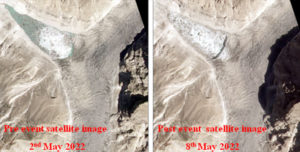In the Himalayas, increasing temperatures and glacier recession have resulted in the formation of new glacial lakes and the expansion of existing ones, posing a threat of triggering glacial lake outburst floods (GLOFs), according to a recent study.
GLOFs occur when the water levels of glacial lakes breach their boundaries, which can cause large amounts of water to flow into nearby streams and rivers, creating flash floods. This can cause devastating impacts downstream including loss of lives, damage to infrastructure and economic loss.
Conducted by the Department of Civil Engineering, Indian Institute of Technology (IIT) Jammu, by Hemant Singh, a Prime Minister Research Fellow (PMRF), under the supervision of Divyesh Varade, the study found that in the Himalayan cryosphere, climate change has increased the occurrence of many natural disasters such as GLOFs and flash floods. Researchers from IIT Roorkee and universities in the U.K. and Bhutan also contributed to the study.
Initiated in May 2022, the study investigated the Mochowar and the Shisper glaciers of the Hunza valley in the Karakoram ranges where the risk associated with GLOFs is evident. It found that the critical vulnerability of the existing ice-dammed lake, formed due to the surging of the Shisper glacier, could be further enhanced from the contributions of a future potential lake, leading to a cascading effect of GLOFs.
In recent decades, the study says, Hunza valley has witnessed 11 GLOF events making it one of the most susceptible regions of the Karakoram ranges. Particularly, the Hassanabad area of the Hunza valley experienced three GLOF events in 2019, 2020 and 2022 due to the Shisper ice-dammed lake.
The Karakoram ranges have already witnessed at least 179 GLOFs over almost five centuries, from 1533 till 2020. Out of these, 156 GLOF hazards occurred in five major valleys — Hunza, Shimshal, Karamber, Shaksgam and Shyok. 120 of these GLOF events were triggered by ice-dammed lakes and occurred between June and August. Out of these GLOF hazards, approximately 32% events have been reported in the Hunza basin (Hunza valley, Shimshal valley), which was identified as the most GOLF-susceptible region of the Karakoram ranges.
Hemant Singh, the primary author of the study, said that in the last four decades, the changes in climate have had a more severe effect in the Himalayan regions as observed by retreating glaciers, declining snow patterns and extreme rainfall.
“The shrinking glaciers imply ice-thinning which may lead to the formation of new glacial lakes. Some of these become susceptible to GLOF events due to various factors such as warming temperature, ice calving from glaciers, flow of debris into the lakes, criticality of the lake’s location, its spatial extent and depth, slope of the lake, and so on. GLOFs severely affect the regional mountain community. The topography and climatology of the Himalayan glaciers could further be another reason for increased susceptibility of these lakes,” Singh told Mongabay India.

He said the number of new glacial lakes that are forming and could further form in the future are expected to be higher in the Karakoram ranges.
Irfan Rashid, who teaches at Department of Geo Informatics, University of Kashmir and has also done research on GLOFs, said that GLOFs remain a persistent threat to downstream communities and infrastructure, besides flora and fauna. “Populations living downstream, less than 20 kilometres away from a glacial lake, face a great threat. These areas need proper monitoring and planning to avoid any casualties,” said Rashid.
He adds that although the Western Himalayas have not been a hotspot for GLOFs, there have been many changes in the last 30 years with the emergence of several new lakes that have the potential to outburst.
The rising threat of GLOFs
GLOFs are a rising concern and affect the health of the Himalayas. “The Himalayas exhibited more GLOF events than any other mountainous area with a frequency of 1.3 GLOFs per year over the last four decades. The changing climate has increased glacier thinning and heterogeneous mass loss globally. These changes clearly indicate the critical health of the Himalayan glaciers,” said Singh.
He added that catastrophic flood episodes not only cause destruction of life, but also result in the gradual geomorphological transformation of the channel leading to erosion and further changes in the regional biodiversity and ecosystem.
Akhtar H. Malik, a field botanist at the University of Kashmir, explains how GLOFs directly or indirectly affect local biodiversity. “When there is a glacier lake outburst, its water flows into lower areas at a very high speed. This causes massive damage to infrastructure as well as to the flora and fauna, and the area becomes uninhabitable or gets fragmented,” Malik said. This then leads to the land becoming barren. “When there is precipitation, it becomes prone to landslides and snow avalanches and causes more devastation,” he said.
Singh suggests that there needs to be more focus on spatio-temporal monitoring of the glacial lakes using satellite data, continuous updation of glacier boundaries and a glacial lake inventory. According to his recent study, urgent and necessary actions are also required for disaster response and preparedness, where the first step could be to focus on hydro meteorological monitoring of the region and the development of an early warning system for rapid response in the likely case of a disaster.



